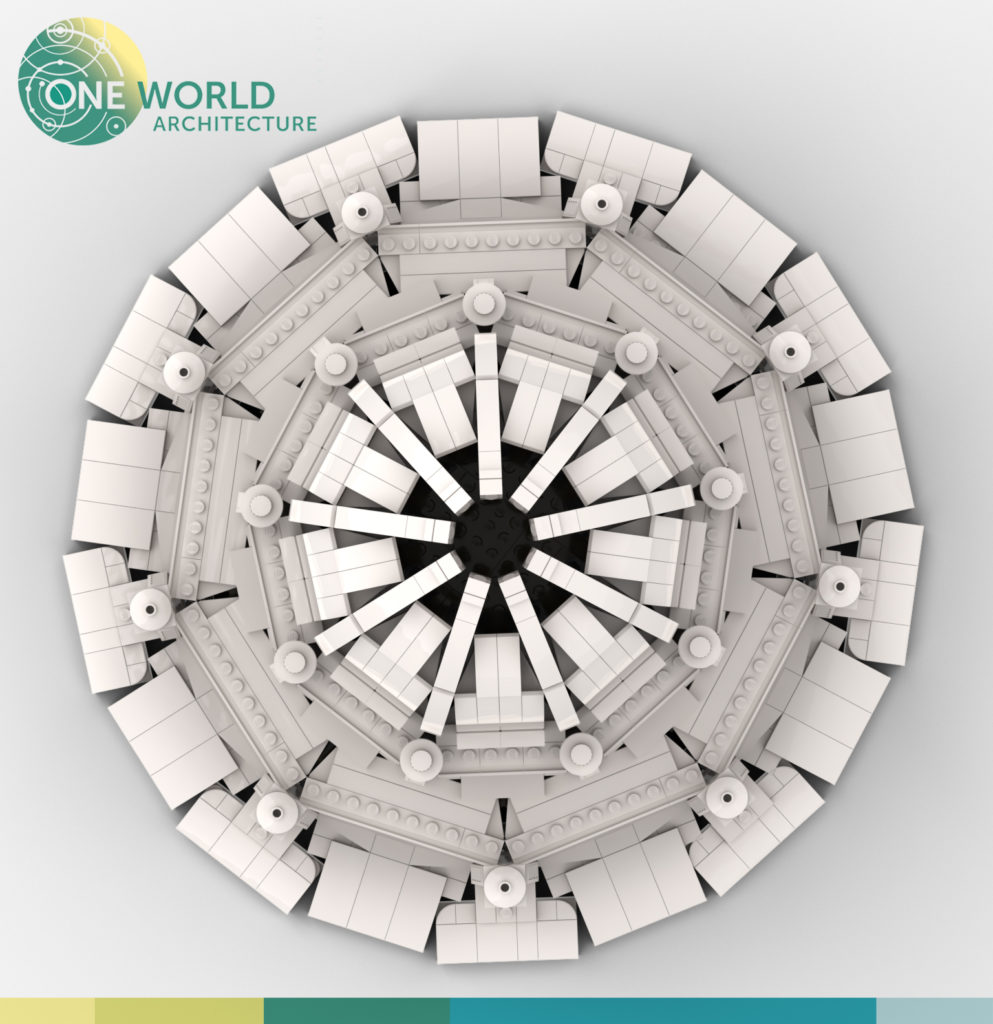
22 Nov The Baha’i Temple: A Crazy Nonagonal LEGO Puzzle
Most architects grew up with building toys. Wooden blocks, stone blocks, Erector sets, and Lincoln Logs. And, our staff’s favorite: LEGO. Building toys encourage multidisciplinary skills, from creative thinking to visual and logical learning. At One World Architecture, we still build with LEGO for fun, exercising our spatial thinking. Our model of Le Corbusier’s Unité d’Habitation is on the cover of the best-selling book, The LEGO Architect, by Tom Alphin. We had tackled this building out of our love of Le Corbusier’s architecture, and to better understand this important historical project. We also created a mid-century modern house for a competition.
Our latest model is of a complex, historic building: the Baha’i Temple in Wilmette, situated along the north shore of Chicago. We have many connections to this building. We were involved in renovating portions of it and its terraces. We were also part of the design team for the Welcome Center adjacent to the Temple. We know every corner and detail of the Temple, which was designed by French Canadian architect Louis Bourgeois in the early 1900s. The Baha’i Faith is found in every country in the world and its key principles involve global peace and social justice.
A Personal Challenge
Years ago, my wife and kids challenged me to create a LEGO model of the Baha’i Temple. It has taken a long time to design the model primarily because of its complexity. It has nine sides, a dome, many curving and sloping surfaces, and ornate carvings throughout the structure. There are almost no flat surfaces or straight lines.
All of these features are very antithetical to LEGO building. Creating a nine-sided form requires working with radial lines and a facade that bends around at 40 degree angles. LEGO models have to sit on a regular orthogonal grid. Aligning these two geometries is a major challenge.
But that’s just the beginning: the upper portion of the Temple is also nine-sided and is rotated 180 degrees from the floor below it, making another difficult shape to conform to the LEGO grid.
Furthermore, I had to account for the multi-sided, tapering pylons, the curved ribs for the dome, the small sections of dome between the ribs, and the arches and columns. Almost every single major element of this building resisted being made out of LEGO.
Over the years, I collected white LEGO parts to test ideas and forms. Occasionally, I would pull the project from the back burner and play with ideas, only to get stumped by the many maddening details of this nonagonal puzzle. I kept changing my mind about what scale to use. Mini, micro, and minifig are the main scales from smallest to largest. Building in minifig scale would have made the model about 5 feet tall. I decided to go with mini scale, which makes the model about 10” tall and 13” wide. It will have about 3,600 parts and weigh about 5 lbs.
For a while, I was using a combination of our architectural CAD software and Bricksmith, a LEGO modeling program to work out the build, but I couldn’t resolve all the crazy angles within the LEGO grid. Recently this year, I discovered Studio, a new LEGO modeling program which allows more precise control with difficult builds. With this new tool, I was able to create a satisfying rendering — a proof of concept that I can now build the physical model.
As soon as I saw the first rendering, I was elated to finally solve my nonagonal puzzle. Next, I’ll collect the parts to build the physical model; I just hope this stage won’t take another six years.





Horvich Michael
Posted at 14:46h, 22 NovemberKen,
What an amazing feat! It looks very much like the temple where a number of Lego’s available kits, approximate the look. I cannot wait to see it completed1
Carol Hannen
Posted at 09:28h, 23 NovemberMy dad, Joseph Hannen and his brother Sohayl used to climb to the top of the temple to remove bird nests. Then, being young and adventurous, would slide down a rope on the outside of the building to the ground. That was probably around 1937 to 1940. My grandfather, John Thomas installed the furnace and saw his future son in law on those ropes and told his wife about the crazy kids. Little did he know several years later he would see one of those kids marry his daughter!
Sue Khavari
Posted at 10:24h, 14 DecemberCongratulations! You have created a lovely model of my favorite building. My husband and I were married there nearly sixty years ago. There is a feeling of peace and happiness at every visit, felt by Baha’is and guests alike. Thank you for your creativity and diligence!
Best wishes to you and your family.
Layli Watts
Posted at 18:04h, 21 NovemberHow can I get this?! 🙂
Pedro Reis
Posted at 02:53h, 25 AprilVery, very nice. Well done.